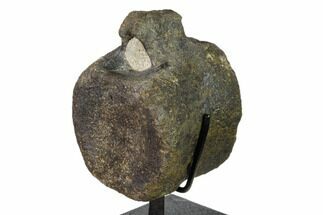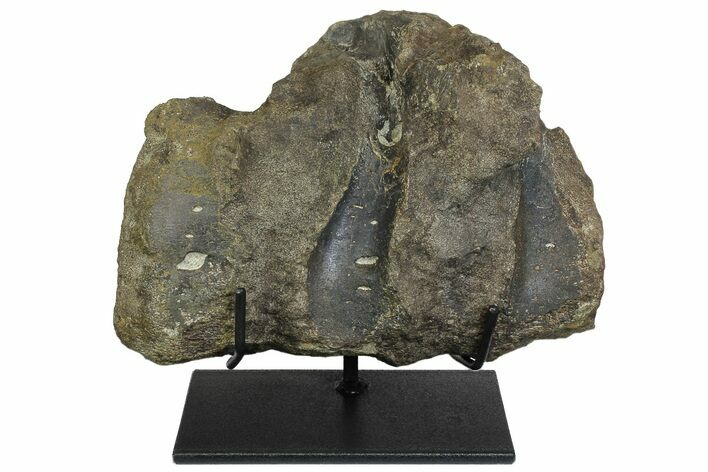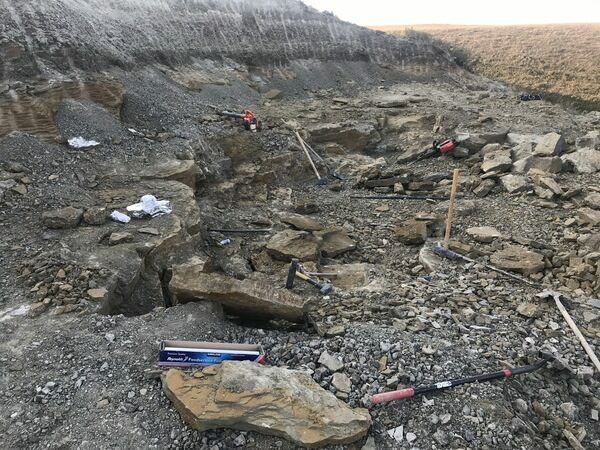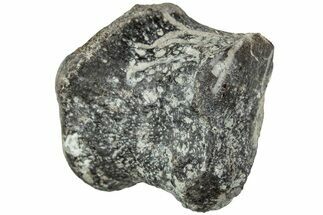This Specimen has been sold.
9.2" Fossil Hadrosaur (Maiasaura?) Fused Sacral Vertebrae - Montana
This is an interesting specimen that was recently collected from the Late Cretaceous age Two Medicine Formation in Pondera County, Montana. What we have here are three sacral vertebrae that naturally fused together during the growth of the Hadrosaur (Maiasaura?). Vertebral fusion was relatively common in large dinosaurs and evidence of this occurrence can be found in specimens dating back to the Late Triassic. Factors that resulted in fused sacral vertebrae are believed to be a combination of ontogeny and evolutionary incorporation of additional sacral vertebrae as dinosaur body sized increased.
The majority of restoration to this specimen can be found along the superior portion of the vertebral arch where the bone crumbled away. Rock has been left within the neural canal for stability purposes. The vertebrae can sit fit on the included metal display stand two separate ways (can be seen in photos above).
The majority of restoration to this specimen can be found along the superior portion of the vertebral arch where the bone crumbled away. Rock has been left within the neural canal for stability purposes. The vertebrae can sit fit on the included metal display stand two separate ways (can be seen in photos above).
Hadrosaurs
are frequently referred to as duck-billed dinosaurs and are members of the Ornithischian family Hadrosauridae. They were fairly common herbivores that roamed Asia, Europe, and North America during the Upper Cretaceous Period. Many species of Hadrosaurs had distinctive crests on their heads, some of which had air-filled chambers that may have produced a distinct sound. These crests may have been used for both audio and visual display purposes.
About The Two Medicine Formation
The Two Medicine Formation is a geographical formation in Central Montana and Southern Alberta, Canada. The formation is predominantly sandstone laid down by rivers and deltas during the Campanian Age of the Cretaceous, about 80-75 million years ago. Approximately two thousand feet thick on the western edge, it lies on top of the Virgelle Sandstone formation and under the Bearpaw Shale. It is located between the Front Range of the Rocky Mountains and the Sweetgrass Arch, a tectonic fold feature 40-90 miles east of the Front Range.
The Two Medicine is the same age as the Judith River Formation found further east. It was laid down further inland from the Western Interior Seaway, while the Judith River Formation was deposited along the coast. The Two Medicine contains much of the same dinosaur fauna, but fewer reptiles, amphibians, and aquatic fossils.
The Two Medicine Formation is a geographical formation in Central Montana and Southern Alberta, Canada. The formation is predominantly sandstone laid down by rivers and deltas during the Campanian Age of the Cretaceous, about 80-75 million years ago. Approximately two thousand feet thick on the western edge, it lies on top of the Virgelle Sandstone formation and under the Bearpaw Shale. It is located between the Front Range of the Rocky Mountains and the Sweetgrass Arch, a tectonic fold feature 40-90 miles east of the Front Range.
The Two Medicine is the same age as the Judith River Formation found further east. It was laid down further inland from the Western Interior Seaway, while the Judith River Formation was deposited along the coast. The Two Medicine contains much of the same dinosaur fauna, but fewer reptiles, amphibians, and aquatic fossils.
SPECIES
Maiasaura sp.?
LOCATION
Pondera County, Montana
FORMATION
Two Medicine Formation
SIZE
9.2 x 7.3 x 5.6"
CATEGORY
SUB CATEGORY
ITEM
#173490
We guarantee the authenticity of all of our specimens.
 Reviews
Reviews























